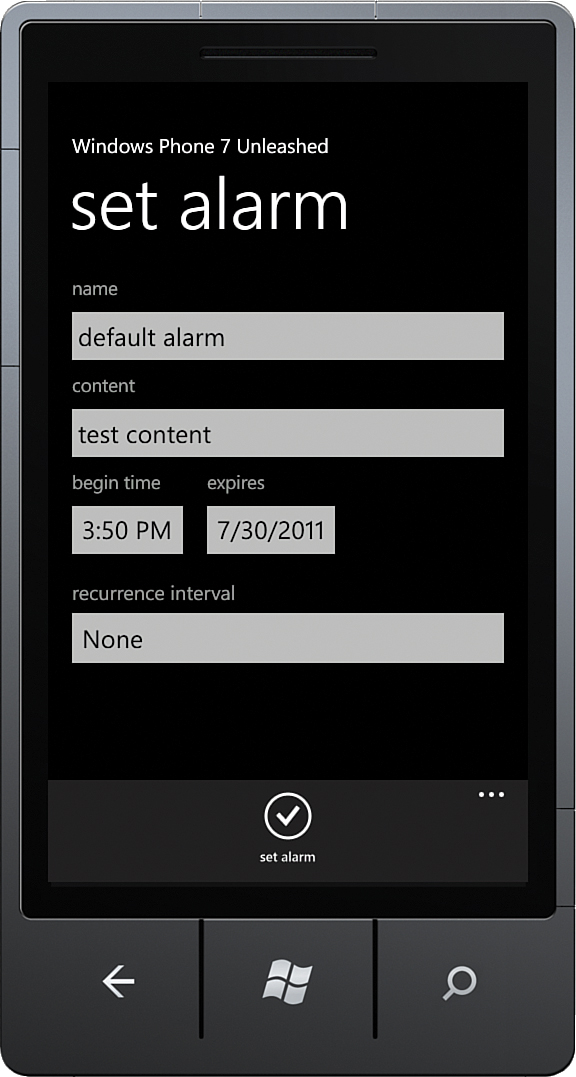Alarm Registration
As previously stated, registering an alarm is done via the ScheduledActionService. When using the ScheduledActionService,
each notification must be given a unique name, or an exception is
raised when you try to add it to the service. In the following example,
we avoid reregistering a notification by detecting whether a
notification with the same name has already been registered. We then
use the ScheduledActionService class’s Add method to register the alarm, as shown:
Alarm alarm = new Alarm(alarmName)
{
BeginTime = DateTime.Now.AddDays(1),
Content = "A test alarm.",
RecurrenceType = RecurrenceInterval.None,
Sound = new Uri("/Sounds/Alarm.wma", UriKind.Relative),
};
if (ScheduledActionService.Find(alarm.Name) != null)
{
ScheduledActionService.Remove(alarm.Name);
}
ScheduledActionService.Add(alarm);
The BeginTime property indicates when the alarm is due to occur. RecurrenceInterval.None specifies that the alarm is not recurring, which need not be specified because it is the default value.
The Alarm.wma audio file is located in the
project and has its Build Action set to Content. When the alarm occurs,
the audio file is played.
The Alarm
class properties are examined in greater detail in the following
section, where you explore the downloadable sample code for this
section.
Alarm Sample
The sample code for this section includes a
page that allows you to enter the details of a new alarm—including its
name and begin time—and to set the alarm via an application bar button.
The code is located in the Alarms directory of the
WPUnleashed.BackgroundAgents project, in the BackgroundAgents solution.
Within the sample, the AlarmViewModel class contains various properties that correspond to the following properties of the Alarm class:
- BeginTime—A DateTime value indicating when the alarm should occur.
- Name—A unique string identifier for the alarm.
- RecurrenceType—A RecurrenceInterval enum value that specifies whether the alarm is a one-time alarm or that it should recur every day or month.
- ExpirationTime—When the alarm is a recurring alarm, this value indicates when the alarm is to be deemed no longer valid and removed by the OS.
- Content—A string that is presented in the alarm dialog when the alarm occurs.
- Sound—When
the alarm occurs, a sound is played. This property is a relative URI to
an audio file within the assembly, allowing you to change the default
sound that is played to one of your choosing.
The viewmodel contains a single ICommand called AlarmSetCommand, which is initialized in the viewmodel’s constructor, as shown:
public AlarmViewModel()
{
alarmSetCommand = new DelegateCommand(obj => SetAlarm());
}
When executed, the command calls the SetAlarm method, which creates a new Alarm using the viewmodel’s property values. The built-in ScheduledActionService is used to register the alarm, as shown in the following excerpt:
void SetAlarm()
{
Alarm alarm = new Alarm(alarmName)
{
BeginTime = alarmBeginTime,
ExpirationTime = alarmExpirationTime,
Content = alarmContent,
RecurrenceType = alarmRecurrenceType,
Sound = alarmSound,
/* Alarm does not support setting the Title. */
// Title = alarmTitle
};
if (ScheduledActionService.Find(alarm.Name) != null)
{
ScheduledActionService.Remove(alarm.Name);
}
ScheduledActionService.Add(alarm);
MessageService.ShowMessage("alarm set");
}
The alarmSound field of the viewmodel is set to a Content resource located in the project’s Sounds directory, as shown:
readonly Uri alarmSound = new Uri("/Sounds/Alarm.wma", UriKind.Relative);
Although nearly all of the viewmodel’s properties are used merely as values for a new Alarm, one property, RecurrenceIntervals, allows the user to pick the recurrence type of the alarm using a Windows Phone Toolkit ListPicker in the view. The ListPicker is bound to the RecurrenceIntervals property of the viewmodel.
Population of the recurrenceIntervals backing field is done using the custom EnumUtility class. The CreateEnumValueList method retrieves the possible enum values using reflection. See the following excerpt:
readonly IEnumerable<RecurrenceInterval> recurrenceIntervals
= EnumUtility.CreateEnumValueList<RecurrenceInterval>();
public IEnumerable<RecurrenceInterval> RecurrenceIntervals
{
get
{
return recurrenceIntervals;
}
}
By using reflection to retrieve the list of enum values, it means they do not have to be hard-coded into the viewmodel.
The view allows the user to set the properties of a new alarm. Windows Phone Toolkit TimePicker and DatePicker controls are used to set the beginning and expiration times of the alarm, as shown in the following excerpt:
<StackPanel Grid.Row="1" Margin="12,0,12,0">
<TextBlock Text="name" />
<TextBox Text="{Binding AlarmName, Mode=TwoWay}" />
<TextBlock Text="content" />
<TextBox Text="{Binding AlarmContent, Mode=TwoWay}" />
<StackPanel Orientation="Horizontal">
<StackPanel>
<TextBlock Text="begin time" />
<toolkit:TimePicker
Value="{Binding AlarmBeginTime, Mode=TwoWay}" />
</StackPanel>
<StackPanel>
<TextBlock Text="expires" />
<toolkit:DatePicker
Value="{Binding AlarmExpirationTime, Mode=TwoWay}" />
</StackPanel>
</StackPanel>
<toolkit:ListPicker
Header="recurrence interval"
ItemsSource="{Binding RecurrenceIntervals}"
SelectedItem="{Binding AlarmRecurrenceType, Mode=TwoWay}" />
</StackPanel>
The view also includes an AppBar with a button that is bound to the AlarmSetCommand, like so:
<u:AppBar>
<u:AppBarIconButton
Command="{Binding AlarmSetCommand}"
Text="Set Alarm"
IconUri="/Images/ApplicationBarIcons/Check.png" />
</u:AppBar>
The various viewmodel properties are initialized with default values. Figure 3 shows the set alarm view, which allows the user to enter the new alarm information.

FIGURE 3 The set alarm view.
When the set alarm button is tapped, the AlarmSetCommand
is executed, registering the alarm with the OS. When the begin time for
the alarm comes around, the alarm dialog is displayed to the user.